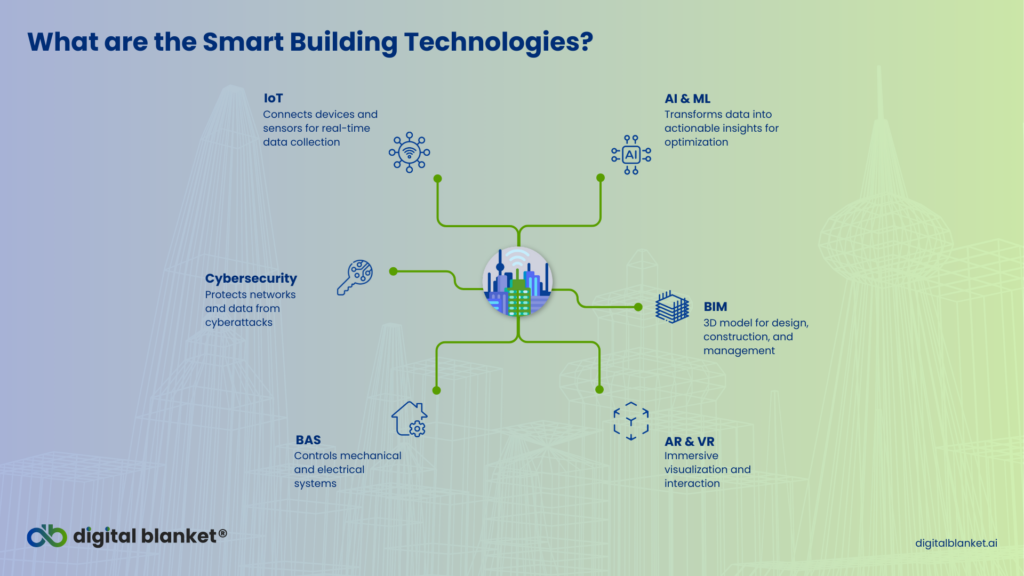Imagine a time before smartphones. Hard, right? Just as phones have evolved, so have buildings. Our urban landscape and buildings are no longer just static structures; they are becoming smart buildings. Dynamic entities that think, adapt, and interact – powered by smart building technologies..The global smart building market, valued at $96.96 billion in 2023, is projected to grow at a CAGR of 21.8% from 2024 to 2032[1].
This transformation is driven by a blend of technologies like IoT, AI, and Building Information Modeling (BIM), creating smart buildings that define the future of real estate. This article delves into smart building tech, its defining features, and the technological components reshaping modern spaces.
What is a Smart Building?
A smart building uses technology to drive efficient, sustainable operations by connecting systems like HVAC, lighting, and security via IoT and AI. These systems adjust automatically based on data inputs to enhance comfort, reduce energy consumption, and improve building management.
What are the features of a smart building?
Smart buildings are characterized by several innovative features that set them apart from traditional structures:
- Automated Controls: IoT enables real-time monitoring and autonomous control of lighting, HVAC, and security.
- Energy Efficiency: Smart tech optimizes energy usage, minimizing waste and lowering costs through adaptive controls and predictive maintenance.
- Enhanced Security: AI-powered surveillance and biometric access create a secure environment.
- Occupant Comfort: Sensors and analytics optimize indoor conditions like air quality and lighting, enhancing occupant well-being.
- Predictive Maintenance: Data insights enable proactive maintenance, reducing downtime.
- Connectivity and Integration: These buildings seamlessly connect multiple systems to create a unified, responsive environment.
These features not only streamline operations but also create a better user experience by making buildings responsive, efficient, and user-friendly.
Smartest Buildings in India
Per a Honeywell report, Indian airports and hotels lead in the usage of smart building technologies with an average Smart Building Score of 49 and 41, respectively[2].
The same report scored IGI Airport, Delhi a perfect 100 in safe and productive parameters and 93 in green, earning the title of the Smartest Large Airport Building for three consecutive years (in 206). Similarly, the Infosys Pune SDB buildings excelled with a 97 score in the safe parameter and high marks in cybersecurity, data analytics, and cloud capability, winning the Smartest Single Occupant Private Office Buildings award in India.
These Indian intelligent buildings have emerged as exemplary models of smart building solutions implemented correctly, paving the way for new buildings and existing building renovations as well.
Technological components behind smart buildings
Smart buildings rely on a multitude of technological components that work in tandem to deliver a seamless and intelligent environment. Below are the key technologies driving this revolution:

Internet of Things (IoT)
IoT is the backbone of smart building technology. So much so, there are a cluster of IoT tech termed ‘smart buildings IoT’. As the name suggests, they enable the connection and communication of various devices and sensors within a building. These IoT for smart buildings collect real-time data on parameters such as temperature, occupancy, energy consumption, and more, feeding this information into centralized systems that optimize building performance.
Artificial Intelligence & Machine Learning (AI & ML)
AI and ML are pivotal in transforming raw data into actionable insights. By analyzing data from smart building IoT, AI algorithms can predict maintenance needs, optimize energy usage, and enhance security protocols.
Alongside, machine learning models continuously learn from data patterns, improving building operations over time and ensuring that intelligent buildings operate at peak efficiency.
Building Information Modeling (BIM)
BIM is a 3D digital building model containing information about its physical structure, systems, and components. It plays a critical role in the design, construction, and management of smart buildings, enabling better collaboration among stakeholders and streamlining the building lifecycle from conception to demolition.
Artificial Reality (AR) & Virtual Reality (VR)
Taking BIM a step further, AR and VR technologies are increasingly being integrated into smart building solutions, providing immersive ways to visualize and interact with building data. For example, AR can be used to overlay maintenance instructions on top of real-world equipment, while VR can train staff to operate complex building systems.
Building Automation System (BAS)
BAS are computer-controlled systems that monitor and manage a building’s mechanical and electrical systems. They are often integrated with IoT for smart buildings and AI to provide more sophisticated control into a unified platform that automates lighting, HVAC, and security processes.
Cybersecurity
With an ever-increasing number of connected devices, cybersecurity is critical to the smart building tech stack. Building owners and operators need to secure their networks and resident data and control devices against cyberattacks.
Importance of data for developing intelligent buildings
In 2006, a British data science entrepreneur, Clive Humby, famously said, “Data is the new oil…”[3]. In the context of smart building technologies, it would not be wrong to say, “Data is the new concrete.”
Driving every aspect of smart building solutions – from proactive maintenance, optimized energy management to personalized occupant experiences, and more – it’s the constant collection of data (by IoT devices) and their analysis (by AI and ML) that help unlock the full potential of smart building technology.
Future trends in smart building technology
As technology continues to evolve, we can expect to see several exciting trends shaping the future of smart building technology:
- Edge computing: The integration of edge computing will enable faster data processing and real-time decision-making, leading to more responsive and efficient building operations.
- Digital twins: Advanced digital twins will provide a virtual representation of a building, allowing for predictive maintenance, energy optimization, and enhanced design and construction processes.
- AI-driven building management: AI will become increasingly sophisticated, enabling buildings to learn and adapt to changing conditions, optimize energy consumption, and improve occupant comfort.
- Internet of Things (IoT) proliferation: The widespread adoption of IoT devices will enable more granular data collection and control—not only of buildings but also of areas around them—leading to greater overall efficiency of smart building solutions.
How to develop a smart building?
Developing a smart building involves a systematic approach that integrates technology, data, and strategic planning:
- Assessment and planning: Begin by assessing the building’s current infrastructure and identifying opportunities for smart technology integration.
- Technology selection: Choose the right mix of IoT devices, AI solutions, and building automation systems tailored to the building’s needs.
- Integration: Ensure seamless integration of all systems, enabling data flow and communication between devices and platforms.
- Data strategy: Develop a data strategy that includes data collection, storage, and analysis, ensuring that data-driven insights can be effectively leveraged.
- Install and test: Once all the smart building tech are installed, thoroughly test the systems to ensure they function as intended.
Building a smart building is not a project but a process. They are dynamic in nature, remember? So, it is critical to continuously monitor and manage the smart building solutions to optimise performance and address any issues that may arise.
Challenges and solutions in implementing smart building technology
According to the UNEP (United Nations Environment Programme), buildings and their construction account for 36% of global energy use and 39% of energy-related carbon dioxide emissions annually[4]. In addition, many construction firms, especially the smaller players in the industry, are apprehensive about the ROI of smart building technology. Then you have data privacy concerns, cybersecurity, maintenance, etc., piling up the challenges.
Still, given the weight of the benefits of smart building solutions, the intelligent building consultants suggest the building stakeholders the following to overcome these challenges:
- Rethink ROI: Carefully evaluate the potential benefits and costs of smart building technology, not just in the short term but also in the long term.
- Invest in standards: Support the development and adoption of open standards that promote interoperability and reduce complexity.
- Implement robust cybersecurity: Protect smart buildings from cyber threats through strong security practices and regular updates.
- Inform tenants of privacy measures: Develop clear policies and guidelines to address privacy concerns to ensure ethical use of data, and educate the potential tenants.
Endnote: Renovate your property with smart building tech
Per a 2016 report, Bangalore has invested the most in smart buildings (57%), potentially owing to newer construction, while Mumbai is catching up second (36%)[2]. Safe to say that as smart building technologies make inroads into buildings around us in India, they are going to be the norm – what all stakeholders seek from real estate developers. So, whether you’re building a new structure or retrofitting an existing one, smart building solutions can help you stay ahead of the curve and reap the benefits of cutting-edge technology.
digital blanket®, recognised in the 2024 Gartner® Market Guide for Workplace Experience Applications, is a solid choice as an intelligent building solution provider, to partner in your next smart building venture.
FAQs
Who invented smart buildings?
The concept of smart buildings evolved through multiple contributions from tech innovators and is not attributed to a single inventor.
What is smart vs intelligent building?
Smart buildings use technology for basic automation, while intelligent buildings utilize advanced AI for adaptive and predictive capabilities. However, in general, the two terms are used interchangeably to refer to buildings that implement smart building technologies discussed in this article.
What are the benefits of smart building technology?
Benefits include improved energy efficiency, enhanced security, predictive maintenance, and a better occupant experience.
What are the three basic components of a smart building?
To different people, different components would make the list of the three basic components of smart building technology. Still, the three most common ones are IoT devices, Building Automation Systems (BAS), and data analytics platforms.
References
[1] https://www.fortunebusinessinsights.com/industry-reports/smart-building-market-101198
[2] https://www.ecoideaz.com/expert-corner/making-buildings-smarter-in-india-the-iot-way
[3] https://comsocsrcc.com/data-is-the-new-oil
[4] https://www.unep.org/resources/report/global-status-report-buildings-and-construction




